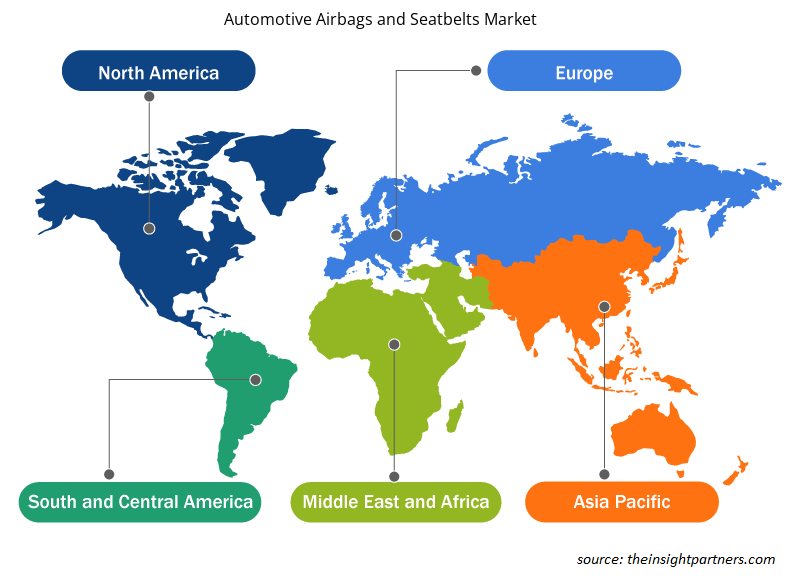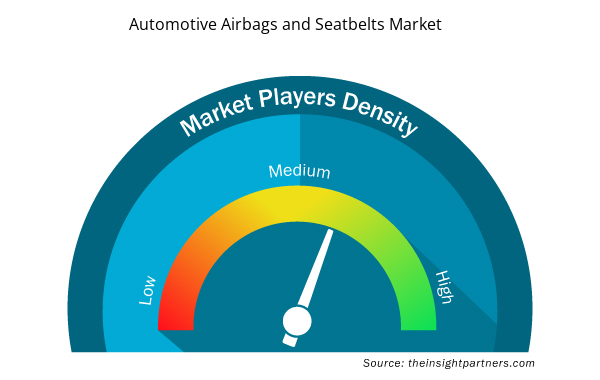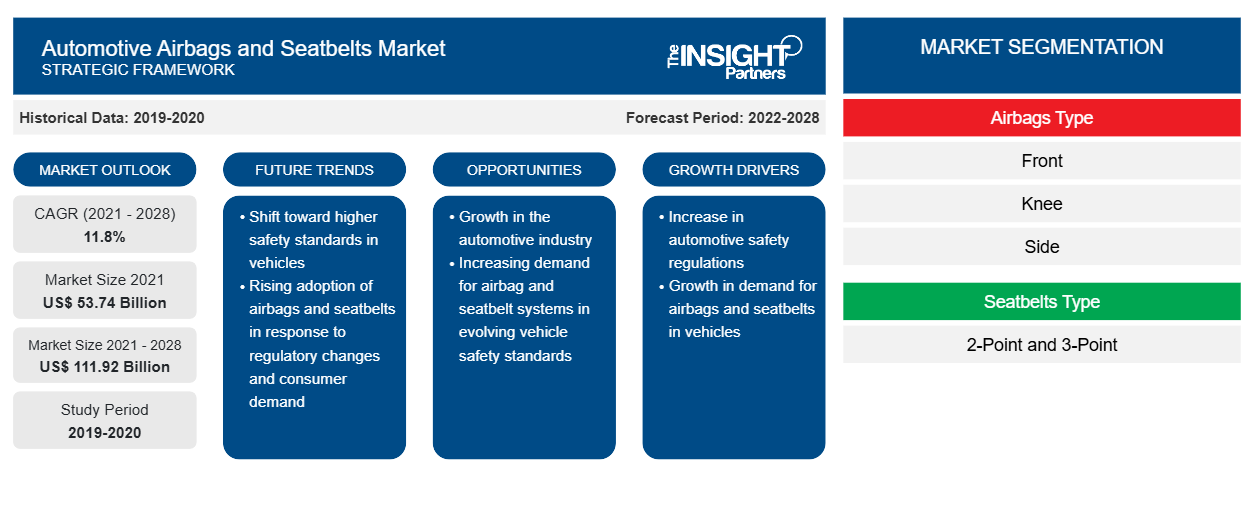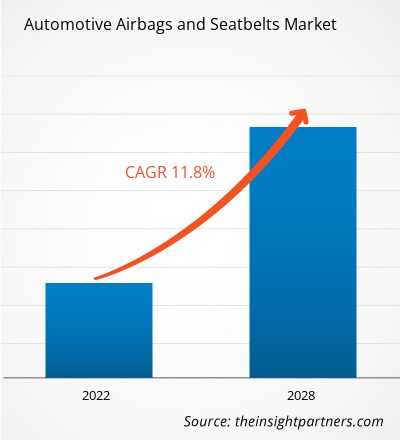2021 年汽车安全气囊和安全带市场价值为 537.44 亿美元,预计到 2028 年将达到 1119.1712 亿美元;预计 2022 年至 2028 年的复合年增长率为 11.8%。
由于出台与车辆安全相关的监管标准的举措越来越多,预计汽车安全气囊和安全带市场的主要参与者 将在未来几年获得丰厚的机会。在新冠疫情爆发后,汽车销量急剧上升,交通事故大幅增加,事故变得越来越频繁和严重。同时,随着科技的快速发展,汽车技术也得到了迅速改进,汽车安全技术逐渐涉及到汽车的各个方面。根据美国国家公路交通安全管理局 (NHTSA) 发布的报告,2021 年的交通死亡人数与 2020 年报告的死亡人数相比增加了约 10.5%。估计的死亡人数是 2005 年以来最高的,也是美国死亡分析报告系统历史上最大的年度百分比增幅。因此,政府机构强烈强调改进安全政策和标准,并在减少道路事故方面投入大量资金。例如,2022 年 5 月,美国国家公路交通安全管理局批准为 402 州和社区补助计划、第 1906 条种族定性数据收集补助和第 405 条国家优先安全计划提供 7.4 亿美元的资金。欧盟委员会正在制定机动车监管标准,考虑到车辆乘员和弱势道路使用者的安全。欧盟委员会计划采用更新的 UNECE 安全带法规,要求从 2019 年 9 月起,新车的所有前排和后排座椅都必须配备安全带提醒系统。因此,此类引入与车辆安全相关的监管标准的举措推动了汽车安全气囊和安全带市场的增长。
电动汽车的日益普及是汽车安全气囊和安全带市场的未来趋势。根据《全球电动汽车展望》,包括全电动和插电式混合动力汽车在内的电动汽车销量在 2021 年增长至创纪录的 660 万辆。根据同一报告,在中国,2021 年电动汽车销量大幅增长至 330 万辆,约占全球总销量的一半。2021 年,欧洲电动汽车销量也强劲增长 65%,达到 230 万辆,美国销量翻了一番,达到 63 万辆。此外,政府对电动汽车充电站的支持性法规进一步推动了电动汽车的销售,从而推动了汽车安全气囊和安全带市场的需求。例如,2022 年 6 月,美国政府为其到 2030 年建设 500,000 个电动汽车充电站全国网络的计划提出了新标准 。此外,政府还推出了一项计划,到 2028 年向各州拨款 50 亿美元资助电动汽车充电器。因此,电动汽车行业的这种增长前景预计将在预测期内推动汽车安全气囊和安全带市场的发展。
定制此报告以满足您的需求
您可以免费定制任何报告,包括本报告的部分内容、国家级分析、Excel 数据包,以及为初创企业和大学提供优惠和折扣
- 获取此报告的关键市场趋势。这个免费样品将包括数据分析,从市场趋势到估计和预测。
COVID-19 疫情对汽车安全气囊和安全带市场的影响
2020 年,全球经济处于顶峰时期,新冠疫情爆发初期对其产生了巨大影响,这场危机阻碍了制造业的商业活动。在新冠疫情爆发之前,人们在开发电动汽车方面投入了大量资金 ,以增加对汽车安全气囊和安全带的需求。在新冠疫情爆发初期,这场危机严重限制了所有商业交易、合作和伙伴关系,扰乱了汽车安全气囊和安全带市场。疫情的爆发阻碍了 2020 年 2 月的汽车销售;此外,到 4 月份,美国汽车销量下降了 47%,欧洲汽车销量下降了 80%。根据 Statista 的报告,2020 年全球汽车销量下降至 6380 万辆,2021 年销量缓慢回升至 6600 万辆。从 2021 年开始,市场参与者见证了部署特定数量安全气囊的强制性规定,这会产生成本。这迫使汽车制造商在疫情恢复期间以同样的成本为汽车提供安全气囊和安全带的附加功能。COVID-19 疫情迅速严重影响了全球一体化的汽车行业。疫情扰乱了中国零部件出口,导致欧洲各地大规模制造业中断,美国装配厂关闭。所有这些因素都导致汽车行业全球对汽车的需求下降。COVID-19 疫情迫使企业重组商业模式,加强战略以实现规模经济。因此,尽管全球安全气囊和安全带市场在 2020 年最初因 COVID-19 疫情和相关法规的不利影响而暴跌,但在 COVID-19 疫情之后实现了强劲复苏。
汽车安全气囊和安全带市场洞察
引入与车辆安全相关的监管标准的举措日益增多
汽车行业是全球经济的支柱产业,在一国经济中发挥着至关重要的作用,有助于建立发达国家和发展中国家的宏观经济增长和稳定,涉及许多相邻领域。新冠疫情后,汽车销量急剧上升,交通事故大幅增加,事故频发,形势严峻。同时,随着科技的飞速发展,汽车技术也得到了快速提升,汽车安全技术逐渐渗透到汽车的各个方面。根据美国国家公路交通安全管理局(NHTSA)发布的报告,2021年的交通事故死亡人数与2020年报告的死亡人数相比增加了约10.5%。估计的死亡人数是2005年以来的最高数字,也是美国死亡分析报告系统历史上最大的年度百分比增幅。因此,政府机构强烈强调完善安全政策和标准,并大力投资减少道路事故。例如,2022 年 5 月,NHTSA 批准为 402 州和社区补助计划、第 1906 条种族定性数据收集补助和第 405 条国家优先安全计划提供 7.4 亿美元的资金。因此,此类引入与车辆安全相关的监管标准的举措正在推动汽车安全气囊和安全带市场的增长。
基于安全气囊类型的市场洞察
根据安全气囊的类型,汽车安全气囊和安全带市场可分为前部、膝部、侧面和窗帘式。正面安全气囊系统越来越多地用于驾驶员安全,世界各地的监管机构都强制使用它们。此外,由于消费者对车辆安全的认识不断提高,可支配收入不断增加,消费者在车辆安全功能上的支出也越来越多。顶级制造商现在为他们的车辆配备侧面安全气囊 (SAB),以减轻侧面碰撞事故中严重的胸部伤害。Autoliv Inc. 于 2019 年推出了一款新型前中央安全气囊;它位于驾驶员和前排乘客之间的区域,可降低胸部、肩部和头部受伤的风险,同时还可在侧面碰撞中挽救生命。
汽车安全气囊和安全带市场区域洞察
Insight Partners 的分析师已详尽解释了预测期内影响汽车安全气囊和安全带市场的区域趋势和因素。本节还讨论了北美、欧洲、亚太地区、中东和非洲以及南美和中美洲的汽车安全气囊和安全带市场细分和地理位置。

- 获取汽车安全气囊和安全带市场的区域特定数据
汽车安全气囊和安全带市场报告范围
| 报告属性 | 细节 |
|---|---|
| 2021 年市场规模 | 537.4亿美元 |
| 2028 年市场规模 | 1119.2亿美元 |
| 全球复合年增长率(2021 - 2028) | 11.8% |
| 史料 | 2019-2020 |
| 预测期 | 2022-2028 |
| 涵盖的领域 | 按安全气囊类型
|
| 覆盖地区和国家 | 北美
|
| 市场领导者和主要公司简介 |
|
汽车安全气囊和安全带市场参与者密度:了解其对业务动态的影响
汽车安全气囊和安全带市场正在快速增长,这得益于终端用户需求的不断增长,这些需求源于消费者偏好的不断变化、技术进步以及对产品优势的认识不断提高等因素。随着需求的增加,企业正在扩大其产品范围,进行创新以满足消费者的需求,并利用新兴趋势,从而进一步推动市场增长。
市场参与者密度是指在特定市场或行业内运营的企业或公司的分布情况。它表明在给定市场空间中,相对于其规模或总市场价值,有多少竞争对手(市场参与者)存在。
在汽车安全气囊和安全带市场运营的主要公司有:
- 奥托立夫公司
- 大陆汽车集团
- 电装公司
- 英飞凌科技股份公司
- 罗伯特·博世有限公司
免责声明:上面列出的公司没有按照任何特定顺序排列。

- 了解汽车安全气囊和安全带市场主要参与者概况
基于安全带类型的市场洞察
基于
安全带类型
,汽车安全气囊和安全带市场分为两点式和三点式。三点式安全气囊和安全带由于其优势特点,预计将占据汽车安全气囊和安全带市场份额的较大份额。印度政府将很快要求汽车制造商在每个座位上安装三点式安全带,包括后排中间座位。腰带已被确定为不如三点式安全带安全。如果发生事故,新法规预计将普遍提高乘客安全。印度道路运输和公路部批准了一份草案通知,要求汽车制造商在可容纳八名乘客的汽车中至少配备六个安全气囊。
汽车安全气囊和安全带市场的参与者采用合并、收购和市场计划等策略来保持其在市场中的地位。以下列出了主要汽车安全气囊和安全带市场参与者的一些发展:
- 2022 年 2 月,Autoliv 公司宣布与自动驾驶汽车公司 Nuro 合作,为 Nuro 最新的第三代汽车提供外部安全气囊等更高的安全性能
- 2021 年 4 月,大陆集团为其安全气囊控制单元开发了新功能。该公司旨在利用控制单元的信号并开发更快展开安全气囊的功能,尤其是在侧面碰撞时。
全球汽车安全气囊和安全带市场根据安全气囊类型、安全带类型和车辆等级进行细分。根据安全气囊类型,汽车安全气囊和安全带市场细分为前部、膝部、侧面和窗帘式。就安全带类型而言,汽车安全气囊和安全带市场细分为 2 点式和 3 点式。此外,根据车辆等级,汽车安全气囊和安全带市场细分为乘用车、轻型商用车和重型商用车。
Autoliv、ZF Friedrichshafen AG、丰田合成株式会社、均胜安全系统和大陆集团是本次研究考虑的主要汽车安全气囊和安全带市场参与者。此外,本研究报告还研究和分析了其他几家重要的汽车安全气囊和安全带市场参与者,以全面了解全球汽车安全气囊和安全带市场及其生态系统。
- 历史分析(2 年)、基准年、预测(7 年)及复合年增长率
- PEST 和 SWOT 分析
- 市场规模价值/数量 - 全球、区域、国家
- 行业和竞争格局
- Excel 数据集



Report Coverage
Revenue forecast, Company Analysis, Industry landscape, Growth factors, and Trends

Segment Covered
This text is related
to segments covered.

Regional Scope
North America, Europe, Asia Pacific, Middle East & Africa, South & Central America

Country Scope
This text is related
to country scope.
常见问题
The growing initiatives for introducing regulatory standards related to vehicle safety and increasing advancements in airbag and seatbelt technologies are driving the Automotive airbags and seatbelts market
The Automotive airbags and seatbelts market is estimated to grow at 111917.12 million US dollars in 2028 at a CAGR of 11.8%.
The growing adoption of electric vehicles is the future trends for the Automotive airbags and seatbelts market.
Autoliv, Inc., Continental AG, TOYODA Gosei Co., Takata India Pvt Litd., Daicel Corporation and Joyson Safety Systems are the key players holding the major market share in the automotive airbags and seatbelts market.
APAC is holding major market share of Automotive airbags and seatbelts market.
Passenger cars is the leading vehicle class segment in the Automotive airbags and seatbelts market.
The incremental growth of Automotive airbags and seatbelts market during the forecast period is US $ 58173.12 million.
Trends and growth analysis reports related to Automotive and Transportation : READ MORE..
The List of Companies - Automotive Airbags and Seatbelts Market
- Autoliv Inc.
- Continental AG
- Denso Corporation
- INFINEON TECHNOLOGIES AG
- Robert Bosch GmbH
- ZF Friedrichshafen AG
- Hyundai Mobis
- Joyson Safety Systems
- Toyoda Gosei Co., Ltd.
- Ashimori Industry Co., Ltd
The Insight Partners performs research in 4 major stages: Data Collection & Secondary Research, Primary Research, Data Analysis and Data Triangulation & Final Review.
- Data Collection and Secondary Research:
As a market research and consulting firm operating from a decade, we have published and advised several client across the globe. First step for any study will start with an assessment of currently available data and insights from existing reports. Further, historical and current market information is collected from Investor Presentations, Annual Reports, SEC Filings, etc., and other information related to company’s performance and market positioning are gathered from Paid Databases (Factiva, Hoovers, and Reuters) and various other publications available in public domain.
Several associations trade associates, technical forums, institutes, societies and organization are accessed to gain technical as well as market related insights through their publications such as research papers, blogs and press releases related to the studies are referred to get cues about the market. Further, white papers, journals, magazines, and other news articles published in last 3 years are scrutinized and analyzed to understand the current market trends.
- Primary Research:
The primarily interview analysis comprise of data obtained from industry participants interview and answers to survey questions gathered by in-house primary team.
For primary research, interviews are conducted with industry experts/CEOs/Marketing Managers/VPs/Subject Matter Experts from both demand and supply side to get a 360-degree view of the market. The primary team conducts several interviews based on the complexity of the markets to understand the various market trends and dynamics which makes research more credible and precise.
A typical research interview fulfils the following functions:
- Provides first-hand information on the market size, market trends, growth trends, competitive landscape, and outlook
- Validates and strengthens in-house secondary research findings
- Develops the analysis team’s expertise and market understanding
Primary research involves email interactions and telephone interviews for each market, category, segment, and sub-segment across geographies. The participants who typically take part in such a process include, but are not limited to:
- Industry participants: VPs, business development managers, market intelligence managers and national sales managers
- Outside experts: Valuation experts, research analysts and key opinion leaders specializing in the electronics and semiconductor industry.
Below is the breakup of our primary respondents by company, designation, and region:

Once we receive the confirmation from primary research sources or primary respondents, we finalize the base year market estimation and forecast the data as per the macroeconomic and microeconomic factors assessed during data collection.
- Data Analysis:
Once data is validated through both secondary as well as primary respondents, we finalize the market estimations by hypothesis formulation and factor analysis at regional and country level.
- Macro-Economic Factor Analysis:
We analyse macroeconomic indicators such the gross domestic product (GDP), increase in the demand for goods and services across industries, technological advancement, regional economic growth, governmental policies, the influence of COVID-19, PEST analysis, and other aspects. This analysis aids in setting benchmarks for various nations/regions and approximating market splits. Additionally, the general trend of the aforementioned components aid in determining the market's development possibilities.
- Country Level Data:
Various factors that are especially aligned to the country are taken into account to determine the market size for a certain area and country, including the presence of vendors, such as headquarters and offices, the country's GDP, demand patterns, and industry growth. To comprehend the market dynamics for the nation, a number of growth variables, inhibitors, application areas, and current market trends are researched. The aforementioned elements aid in determining the country's overall market's growth potential.
- Company Profile:
The “Table of Contents” is formulated by listing and analyzing more than 25 - 30 companies operating in the market ecosystem across geographies. However, we profile only 10 companies as a standard practice in our syndicate reports. These 10 companies comprise leading, emerging, and regional players. Nonetheless, our analysis is not restricted to the 10 listed companies, we also analyze other companies present in the market to develop a holistic view and understand the prevailing trends. The “Company Profiles” section in the report covers key facts, business description, products & services, financial information, SWOT analysis, and key developments. The financial information presented is extracted from the annual reports and official documents of the publicly listed companies. Upon collecting the information for the sections of respective companies, we verify them via various primary sources and then compile the data in respective company profiles. The company level information helps us in deriving the base number as well as in forecasting the market size.
- Developing Base Number:
Aggregation of sales statistics (2020-2022) and macro-economic factor, and other secondary and primary research insights are utilized to arrive at base number and related market shares for 2022. The data gaps are identified in this step and relevant market data is analyzed, collected from paid primary interviews or databases. On finalizing the base year market size, forecasts are developed on the basis of macro-economic, industry and market growth factors and company level analysis.
- Data Triangulation and Final Review:
The market findings and base year market size calculations are validated from supply as well as demand side. Demand side validations are based on macro-economic factor analysis and benchmarks for respective regions and countries. In case of supply side validations, revenues of major companies are estimated (in case not available) based on industry benchmark, approximate number of employees, product portfolio, and primary interviews revenues are gathered. Further revenue from target product/service segment is assessed to avoid overshooting of market statistics. In case of heavy deviations between supply and demand side values, all thes steps are repeated to achieve synchronization.
We follow an iterative model, wherein we share our research findings with Subject Matter Experts (SME’s) and Key Opinion Leaders (KOLs) until consensus view of the market is not formulated – this model negates any drastic deviation in the opinions of experts. Only validated and universally acceptable research findings are quoted in our reports.
We have important check points that we use to validate our research findings – which we call – data triangulation, where we validate the information, we generate from secondary sources with primary interviews and then we re-validate with our internal data bases and Subject matter experts. This comprehensive model enables us to deliver high quality, reliable data in shortest possible time.


 获取此报告的免费样本
获取此报告的免费样本